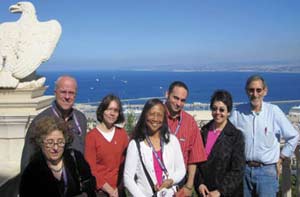U.S. Delegation Discusses Statistics with Israelis
Nancy Geller

ASA People to People delegation to Israel overlooking the port at Haifa. From left: Marianthi Markatou, Robert Easterling, Graciela Gonzalez-Farias, Juanita Tamayo Lott, Brian Sloboda, Nancy Geller, and Herbert Geller
The 2011 People to People trip to Israel was a fine mix of sightseeing and professional visits. We spent most of our time in the vicinity of Tel Aviv, Haifa, and Jerusalem.
The professional visits were a key component of the program, covering a wide variety of statistical activities. We met with groups from academic statistics departments at the University of Tel Aviv and Hebrew University, Jerusalem; with several members of the Consulting Laboratory of the Technion; with a statistics group within the Gertner Institute, a nonprofit epidemiology and health policy institute; with the CEO and chief statistician of Technostat, an international biostatistics consulting firm that deals with medical devices and pharmaceuticals; with a group from Teva Pharmaceuticals, a large pharmaceutical company joined by the president of the Israeli Statistical Association; with the executive director of the United States-Israel Binational Science Foundation; and with a group from the Israeli Central Bureau of Statistics, including the government statistician.
The purpose of the trip was to discuss matters of common interest to statisticians. The topics included statistical literacy and general statistical education for various majors in college, training problemsolvers for all sectors (academia, industry, and government), professional development, continuing education, and roles of statisticians in official statistics.
ASA members have already been invited to participate in the next ASA People to People Delegation, which will travel to Russia September 6–14 and be led by ASA President Bob Rodriguez. For additional information, contact Ron Wasserstein, ASA executive director, at ron@amstat.org.
One big difference between studying in Israel as compared to the United States is that Israeli students tend to be older than American students, because most high-school graduates spend two to four years in the military before enrolling at a university. This implies that students are several years older when they earn their degrees and, perhaps, more mature. University applicants apply to a particular program, rather than choosing their majors while at the university. Statistics students often have a joint major, with computer science and mathematics being the most popular majors combined with statistics. On the whole, statistics graduates obtain employment in Israel. The shortage of well-trained statisticians to fill applied positions was noted often. On-the-job training in the industrial sector was common.
Other themes that entered many of our discussions were the public perceptions of statistics and statisticians and education and training on all levels. As in the United States, statisticians in Israel need to improve their public image. Statistics groups in academic settings all provided some kind of continuing education for nonstatistical colleagues such as short courses or other tutorials. Consulting with others who had applied problems was common in the academic setting.
Delegates spent a morning with representatives from the Israeli Central Bureau of Statistics (CBS), which functions independently of the government although it is the government’s statistical arm. The CBS’s role is to collect, process, and publicize statistical information about the population, economy, and society in Israel. In addition, the bureau is responsible for coordinating statistical activity of government institutions and advising them on statistical issues. The CBS supplies data, but does not make policy. Since Israel’s founding in 1948, data have been collected via censuses and administrative records, which may be linked because each resident has a unique identification number.
Delegates were warmly welcomed everywhere with fine hospitality—always sweets and cold drinks. If you have never tasted “rugalach,” that alone is worth the trip!
You can read our journal, which provides details and includes several photos, on the People to People website under Science and Technology. For a heavily detailed and personal report, see Rob Easterling’s blog.
We do hope you’ll join the 2012 delegation to Russia, which promises to be another stimulating and interesting experience.

















